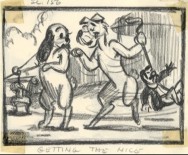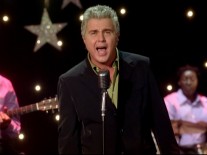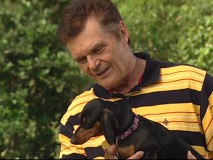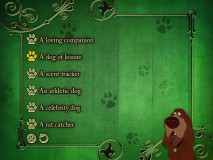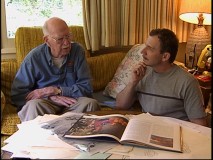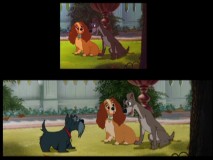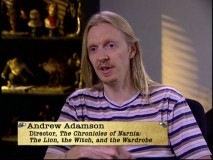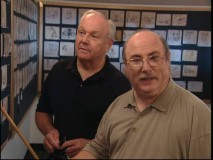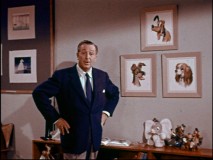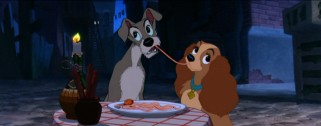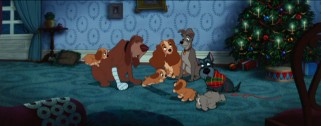Page 1: The Movie, DVD History, Video and Audio, Disc 1 Bonus Features Page 2: Disc 2 Bonus Features, Menus and Packaging, Closing Thoughts
DISC 2 BONUS FEATURES Like most of Disney's modern DVDs that have a multitude of bonus features, Lady and the Tramp's supplements are divided into four sections on Disc 2. First is Deleted Scenes, which holds one discarded sequence and a couple of alternate versions of a piece which can be found in the film itself. Each is introduced and aptly contextualized by animator Eric Goldberg, who clearly serves as something of an unofficial host for the entire disc. "Turning the Tables" (3:00), the first segment, finds Tramp dreaming about what things would be like if dogs were the masters of humans; all the condescending mannerisms of an owner/dog relationship are reversed in Music & More offers two brief bonuses. First, Goldberg introduces "'The Siamese Cat Song': Finding a Voice for the Cats" (4:16). He explains that the filmmakers tried several techniques to achieve the vocals of the mischievous pair of cats finally dubbed Si and Am. This sets up excerpts of three performances given by two males: one in high registers, one elongated, and that second one again sped-up (the elongation's intention), as well as a brief clip from the version ultimately chosen, Peggy Lee's overdubbed with herself. Next is a music video, but not the Disney Channel / teen pop stars trite you might expect/fear. Instead, it's some guy named Steve Tyrell singing "Bella Notte" (2:52) amidst plenty of imagery from the film and some sets inspired by it. Neither the video nor the performance are as offensive as usual - consider that an endorsement if you must. Out of pure coincidence, this is one of 13 tracks on The Disney Standards, an album released the same day as this DVD. Under the heading Games & Activities, one finds four more listings. "Disney Virtual Puppy" requires a DVD-ROM drive, but it is actually worth that effort for anyone who finds merriment in computer activities. This is basically a more graphically appealing, less time-demanding version of the Tamagotchis that caught on in the late 1990s. You pick one of five dogs (Disney Cutie-esque versions of Lady, Tramp, Jock, Trusty, and the bulldog) and name it. At this point, you can print a certificate and adoption license with your and your dog's names on it. Then, you proceed to tend to your new virtual pet, by making sure he or she stays happy, energized, fed, and educated. If you provide a balanced diet and proper doses of attention and rest, you'll notice your dog learning new tricks. Altogether, there are ten that the pup eventually will grasp and you could effectively master this in about a half hour or so. Otherwise, you can just have fun petting your pet (just not during eating/drinking time), watching it perform tricks, and hearing what sounds like the typical Disney trailer guy provide commentary on your actions. While most of the time, DVD-ROM stuff is promotional or a waste of time, this is an exception. There's even wallpapers and screensavers featuring any of the five Virtual Puppies or the lot of them together.
Next, the virtual board game "Disney Dog Trivia" is a worthy candidate for the title of Disney's best set-top DVD game ever. Well, that is when you play the "Family" version, which welcomes 2-4 players or teams. Here, play proceeds like a trivia-based board game, players take turns and press the "Enter" button to see what the spinner lands on. The multiple choice questions are divided into six categories, dealing with Male, Female, Animated, and Live Action dogs, Lady and the Tramp, or any of the above via something called "Visual Clues." Sometimes you'll land on a space which enables you to pick the category; more often, the category is dictated for you. Gameplay is impressively designed to resemble a three-dimensional board game, which you move through as if you are a piece. The questions cover the entire Disney canon, though most will probably find too many dealing with direct-to-video sequels such as 101 Dalmatians II. Still, less obvious sources are summoned such as Nikki, The Wild Dog of the North, The Nightmare Before Christmas, Lilo & Stitch and recent acquisition The Muppet Movie. While Disney aficionados won't find themselves stumped frequently, there is a rather solid balance to the questions, though ultimately who wins seems more determined by what random opportunities are posed to them than who knows their Disney stuff. Play proceeds until one person has obtained eight ribbons - though it's not likely to be the same each time, it seems not too short and not too long, just right. The alternative way to play is "Junior", designed for those flying solo. This way, you simply answer as many of the ten trivia questions lobbied, without any of the spinning or board action. Like other "Disneypedia" featurettes, this disc's piece "Going to the Dogs" (9:20) is aimed at children, but is informative and fun for those of all ages. Your comedic host is Fred Willard (of Anchorman and Chicken Little), who checks out the action at a dog park and encounters some interesting canines. The featurette covers seven different types of dogs: Sporting, Hound, Terrier, Toy, Non-Sporting, Herding, and Working, with a mix of stock footage and clips from Disney movies including obvious dog flicks like Air Bud, Oliver & Company, and The Shaggy D.A., plus a few other less obvious choices like Pocahontas (stretched to fill the screen) and The Little Mermaid. Rounding out the section, "Your Inner Bark" follows the formula of other personality profile activities and succeeds in providing a bit of entertainment as you answer seven questions based on your preferences and wind up being assigned the Lady and the Tramp character that you are most like. A return trip finds that most of the questions are not the same. I got Trusty. We then move on to final section Backstage Disney, which should appeal most to readers of this site. Its largest and most exciting feature is "Lady's Pedigree: The Making of Lady and the Tramp", which can be viewed as seven featurettes or as one 52½-minute documentary. The piece begins with "Return to Marceline" (5:25), a nicely-photographed segment on the small Missouri town that was home to Walt's brief but influential country upbringing, which it indisputably argues can be seen in the nostalgic vision of Lady that contrasted with the upheaval the real world saw in the mid-1950s. There are interviews with Walt's childhood friends and animation historians like John Canemaker to ponder the movie's origins.
Next, "A Perfect Little Lady: The Story of Lady and the Tramp" (12:10) mostly serves to give apparently long-overdue credit to Joe Grant, the story man who left Disney in the '50s and went uncredited for the concepts he devised for Lady. (As you may know, he returned to the studio in the 1990s and stayed there until his death last May.) This fascinating portion also covers the sources often attributed for the film, like the Ward Greene novel that Walt commissioned (after liking a short story by Greene) and the possible tall tale of Walt's puppy-in-a-box gift to his wife. In As you could probably guess, "Ruff Animation" (11:30) deals with the film's animation. It offers praise for visual achievements (such as dog movement) and also informs us of what those of Walt's Nine Old Men brought to the characters they were in charge of. We briefly hear from the last living animator, Ollie Johnston, but settling for modern day animators' anecdotes and recollections from the sons of Woolie Reitherman is not so bad. "Canine Chorus: The Music of Lady and the Tramp" (7:55), another self-explanatory piece, takes the similar route in getting interviews with the offspring of song creators Peggy Lee and Sonny Burke. The contributions and styles of Lee and Burke, as well as the Mello Men and composer Oliver Wallace, are remembered, with plenty of insight from Mike Gabriel (who co-directed Pocahontas with Goldberg) among others. "Teaching a Dog to Talk: The Voices of Lady and the Tramp" (4:25) is clearly hindered by the fact that apparently the only living member of the cast is Stan Freberg, who does appear to talk at length about his bit part as Beaver. Modern animators reflect on the "fun" that the movie has with dialects and accents. "Pretty As A Picture: Art and Design" (8:15) spends much of its time on Lady's use of CinemaScope, as subjects remark upon the tricks used to convert from Academy to CinemaScope following the decision to go wide, the aforementioned Academy Ratio filming that had to be done for non-equipped theaters (which is demonstrated with some split-screen clips), and how CinemaScope came about anyway. Finally, "Epilogue: Return Home" (2:30) takes us back to Marceline to recall how Walt left the town, but never forgot it. Nor has the town forgotten him, apparently, as footage shows a farm house where several people recently wrote and signed messages to their hometown hero. Overall, "Lady's Pedigree" is clearly the centerpiece of the movie-based bonus features and it's a solid one. Some segments obviously work better than others, but it is well-paced and consistently both informative and interesting. Its use of clips from the movie and other bonus features are in moderation, and they can be viewed in their entirety elsewhere. Breaking it up as Disney did, enables you to enjoy as much as time allows, which is nice. Watching it all in one sitting, nonetheless, offers an especially rewarding (and educational) experience.
Next are two storyboard-related featurettes which are given separate listings, but play in succession if you select the first. "Finding Lady: The Art of Storyboards" (13:00) offers a history of storyboards, not strictly related to Lady. In fact, it's not even limited to Disney films. While plenty of attention is given to story pitches and stills from vintage and modern Disney animated classics such as Bambi, Dumbo, Pinocchio, and Beauty and the Beast, a lot is also given to live action films, from present day Disney fare like The Greatest Game Ever Played and The Chronicles of Narnia: The Lion, The Witch and the Wardrobe to Hitchcock thrillers The Birds and Saboteur to ... Open Range. That's right, there is way too much Kevin Costner in this featurette, which is representative of its biggest shortcoming. The piece seems dictated by whoever they could get to appear (like Costner and Hitchcock screenwriter Peter Viertel), as opposed to having the participants complement an overview of storyboards in cinema. Of course, Lady and specifically, its long journey from development to screen, is mentioned but without it, this piece could really wind up on any other DVD, Disney or not. The second part, "Original 1943 Storyboards" (11:50), is more relevant and satisfying. This provides an abbreviated retelling of the original concepts of the film (then called simply "Lady") narrated by Burny Mattinson and (you guessed it) Eric Goldberg. Like the deleted scenes, this piece is well-edited to convey more than simple drawings. It's fascinating to see how much changed in the process of production and Goldberg and Mattinson have fun with voicing the movie's characters in their earlier incarnations. If you haven't gotten to this featurette from "Finding Lady" then you'll definitely be puzzled by the "Enjoy these movies now available for sale or rental" at the end. Open Range?! Under the header "Excerpts from 'Disneyland' TV Shows", one can find significant portions from two mid-1950s installments of Walt's then-new weekly anthology series. Goldberg narrates a 4-minute introduction explaining the innovative nature of Walt's "Disneyland" program and, in more detail than most will care, how the erratic picture quality of the two episode excerpts is the best that could be offered after extensive efforts and multiple color sources. "The Story of Dogs" (December 1, 1954) (17:27) provides a fascinating look inside Lady's production, beginning with Walt's introduction and moving on to an overview of the story with sketches told by writer Ed Penner, a scene performance by three members of the voice cast (Barbara Luddy, Bill Thompson, and Bill Baucom as Lady, Jock, and Trusty), and character animation with Frank Thomas and Milt Kahl. The finished version of the preceding elements acts as preview, before backgrounds and layouts are covered, and another sequence -- this one the dogs-chase-Lady scene in unfinished form -- is seen.
"Cavalcade of Song" (February 16, 1955) (21:38) focuses on the music of Lady and the Tramp, featuring another abbreviated story run-through by Penner, a fictionalized take of Peggy Lee and Sonny Burke's collaborative creation of the "Siamese Cat Song", highlights of other songs from the film, and a performance of "He's a Tramp" by Lee and company in real life and animated forms. Though somewhat staged and simplified, these two excerpts compellingly foreshadow the types of featurettes that are commonplace on today's Trailers from three of Lady and the Tramp's theatrical engagements are provided: an extensive, old-fashioned Scope preview from its 1955 debut (3:45) which outlines all the characters, a brief one from 1972 (0:40) emphasizing the name Disney for "fine family entertainment", and a Christmas-themed one (1:25) for the December 1986 re-release. As Disney rarely offers trailers on its vintage live action movies and just about never preserves them on the discs featuring today's new films themselves, it's nice to get three very different promos included here. Finally, there are the galleries, which are separated into five headings and can be viewed as either navigable still frames with thumbnails or a no-hands-needed slideshow that spends five seconds on each image. The latter route also enables you to skip through the images one by one, so I don't think there could be a more user-friendly gallery. The only problem is a major one but with a simple solution: hit the "Mute" button. Otherwise, during navigation of the thumbnails, the same strand of music is repeated literally ad nauseam; it begins anew each time you turn a page or return to the menu. The same issue afflicted Cinderella and while it's easily resolvable, the producers really ought to leave music out of this section. It doesn't liven things up as much as drive the viewer crazy. Altogether, there are 332 stills to peruse. The largest section, "Visual Development", contains 105 images, most depicting conceptions of various scenes in the movie in either black & white or color. It also holds plenty of drawings from the deleted scene "Turning the Tables", a few pictures which merely seek to set the visual mood, and blueprints for some of the rooms and items inside Lady's house. "Character Design" reveals developments in the appearances of the Siamese Cats (subtle), Lady (a bit less subtle), and Tramp (pretty drastic) in 18-still galleries devoted to each. Its final section offers 22 sketches of Miscellaneous Characters like Aunt Sarah, Jock, Trusty, Peg, and the pound dogs. "Storyboard Art" provides 42 mostly uncolored and rough visualizations of shots from the movie. "Layouts and Backgrounds" (41 frames) delivers just that, typically wide, uninhabited locales from the film including Lady's street, its houses, and the areas where Tramp roams. Finally, "Production Photos" (68 frames) gives us many black and white stills of the dogs that inspired the animators (often depicted observing them), a few of the voice actors and musical performers, plenty of photos inside miniature models of different parts of Lady's house, and some interestingly featuring humans acting out scenes as Jim Dear, Darling, Tony, and Joe, used of course as live action reference for the animators.
MENUS and PACKAGING The DVD's 16x9-enhanced menu screens take a fairly basic approach, but one which seems suitable. Disc 1's Main Menu is a living room with an active fireplace and various pictures of Lady and Tramp located around it. A couple of different pieces of score accompany the Like the majority of Platinum Editions, Lady and the Tramp is packaged in a standard-width black keepcase and housed in a cardboard slipcover. Unlike past entries, this one's slipcover does not "open like a book" to tout the bonus features and restoration held within. The slipcover's design does ever so slightly differ from the keepcase's artwork, namely because Si and Am adorn the opening which reveals the back cover's UPC code. This, like the side snaps on the keepcase, marks a step taken to prevent thievery in retail. Inside the case is the third installment of the publication Disney DVD Insider. This Spring 2006 issue features Ariel on the cover and 2 pages are devoted to promoting her film's October Platinum Edition release. Two other pages talk creatures with The Lion, The Witch and The Wardrobe's Ben Wootten, while other "articles" advertise the Disney Princess line, Howl's Moving Castle, Chicken Little, Pooh's Grand Adventure, and Dumbo: Special Edition. There are also coupons for candy, pasta sauce, and paper towels, three elements essential to any good Lady and the Tramp DVD gathering! A six-sided fold-open insert provides the usual information: navigational overview, scene selection list, bonus feature descriptions, and a paragraph on "The Platinum Editions."
CLOSING THOUGHTS As a film and as a DVD, Lady and the Tramp: Platinum Edition merits a hearty recommendation for all. If you were an early format adopter or passionate second-hand tracker and have the film's Limited Issue disc, this set may be the biggest no-brainer upgrade ever offered. Picture and sound are vastly improved, thanks to thoughtful digital remastering and the fact that the CinemaScope production's entire width is preserved. Plus, bonus features are abound. Though the set definitely seems more lightweight in the supplements department than most Platinum DVDs, especially with regard to making-of material, basically everything here is quite good. The lengthy documentary offers a satisfyingly comprehensive look at the film's production and importance, while even the Games & Activities section provides a more entertaining and widely appealing selection than unusual. If you haven't yet found a single Disney DVD worth getting in 2006, this is definitely one to break your streak with. Boasting an excellent feature presentation, an impressive slate of accompanying bonuses, and a movie which is near impossible not to like, Lady and the Tramp: Platinum Edition deserves a spot in every DVD collection. More on the DVD / Buy from Amazon.com
Page 2: Disc 2 Bonus Features, Menus and Packaging, Closing Thoughts |

